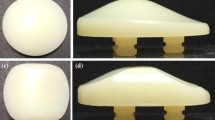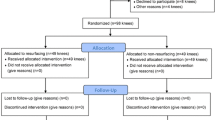Abstract
Introduction
The Genesis II knee system incorporates 3° of external rotation into the femoral component and the femoral component is implanted in neutral rotation to the femur. The purpose of this study was to compare patellar tracking of the Genesis II knee system with that of the Vanguard knee system, in which the femoral component is routinely implanted in a 3° externally rotated position to the posterior condylar axis (PCA) of the femur.
Materials and methods
One hundred consecutive knees scheduled to undergo total knee arthroplasty (TKA) were enrolled. Fifty knees underwent TKA with the posterior-stabilized (PS) Genesis II prosthesis and 50 knees underwent TKA with the PS Vanguard prosthesis. Rotation of the femoral component was calculated by measuring the acute angle between the transepicondylar axis (TEA) and the PCA on axial computed tomography (CT) images. The postoperative patellar tilt and displacement were compared between groups. The range of motion and Knee Society scores were also compared.
Results
Forty-eight knees in each group were followed up for 2 years. There was no difference in the angle between the PCA and the TEA on postoperative CT scans between the two designs. There was also no difference in patellar tracking between groups. Both the Genesis II and Vanguard knee systems showed good clinical results at 2 years postoperatively.
Conclusion
The patellar tracking of the Genesis II prosthesis was comparable to that of the Vanguard prosthesis.
Level of evidence
Prospective cohort study, Level II.



Similar content being viewed by others
References
Anglin C, Brimacombe JM, Hodgson AJ, Masri BA, Greidanus NV, Tonetti J et al (2008) Determinants of patellar tracking in total knee arthroplasty. Clin Biomech (Bristol, Avon) 23:900–910
Anouchi YS, Whiteside LA, Kaiser AD, Milliano MT (1993) The effects of axial rotational alignment of the femoral component on knee stability and patellar tracking in total knee arthroplasty demonstrated on autopsy specimens. Clin Orthop Relat Res 287:170–177
Colwell CW Jr, Chen PC, D’Lima D (2011) Extensor malalignment arising from femoral component malrotation in knee arthroplasty: effect of rotating-bearing. Clin Biomech (Bristol, Avon) 26:52–57
Luring C, Perlick L, Bthis H, Tingart M, Grifka J (2007) The effect of femoral component rotation on patellar tracking in total knee arthroplasty. Orthopedics 30:965–967
Lynch AF, Rorabeck CH, Bourne RB (1987) Extensor mechanism complications following total knee arthroplasty. J Arthroplast 2:135–140
Ranawat CS (1986) The patellofemoral joint in total condylar knee arthroplasty. Pros and cons based on five- to ten-year follow-up observations. Clin Orthop Relat Res 205:93–99
Laskin RS (1995) Flexion space configuration in total knee arthroplasty. J Arthroplast 10:657–660
Rhoads DD, Noble PC, Reuben JD, Mahoney OM, Tullos HS (1990) The effect of femoral component position on patellar tracking after total knee arthroplasty. Clin Orthop Relat Res 260:43–51
Ezzet KA, Hershey AL, D’Lima DD, Irby SE, Kaufman KR, Colwell CW (2001) Patellar tracking in total knee arthroplasty: inset versus onset design. J Arthroplast 16:838–843
Theiss SM, Kitziger KJ, Lotke PS, Lotke PA (1996) Component design affecting patellofemoral complications after total knee arthroplasty. Clin Orthop Relat Res 326:183–187
Merchant AC (2001) Patellofemoral imaging. Clin Orthop Relat Res 389:15–21
Aglietti P, Insall JN, Cerulli G (1983) Patellar pain and incongruence. I: measurements of incongruence. Clin Orthop Relat Res 176:217–224
Hofmann AA, Plaster RL, Murdock LE (1991) Subvastus (Southern) approach for primary total knee arthroplasty. Clin Orthop Relat Res 269:70–77
Gomes LS, Bechtold JE, Gustilo RB (1988) Patellar prosthesis positioning in total knee arthroplasty. A roentgenographic study. Clin Orthop Relat Res 236:72–81
Unver B, Karatosun V, Bakirhan S (2005) Ability to rise independently from a chair during 6-month follow-up after unilateral and bilateral total knee replacement. J Rehabil Med 37:385–387
D’Lima DD, Chen PC, Kester MA, Colwell CW Jr (2003) Impact of patellofemoral design on patellofemoral forces and polyethylene stresses. J Bone Joint Surg Am 85A(Suppl 4):85–93
Engh GA, Parks NL, Ammeen DJ (1996) Influence of surgical approach on lateral retinacular releases in total knee arthroplasty. Clin Orthop Relat Res 331:56–63
Kessler O, Patil S, Colwell CW, D’Lima D (2008) The effect of femoral component malrotation on patellar biomechanics. J Biomech 41:3332–3339
Lewonowski K, Dorr LD, McPherson EJ, Huber G, Wan Z (1997) Medialization of the patella in total knee arthroplasty. J Arthroplast 12:161–167
Matsueda M, Gustilo RB (2000) Subvastus and medial parapatellar approaches in total knee arthroplasty. Clin Orthop Relat Res 371:161–168
Bourne RB, Laskin RS, Guerin JS (2007) Ten-year results of the first 100 Genesis II total knee replacement procedures. Orthopedics 30:83–85
Kaper BP, Woolfrey M, Bourne RB (2000) The effect of built-in external femoral rotation on patellofemoral tracking in the genesis II total knee arthroplasty. J Arthroplast 15:964–969
Laskin RS, Davis J (2005) Total knee replacement using the Genesis II prosthesis: a 5-year follow up study of the first 100 consecutive cases. Knee 12:163–167
Bindelglass DF, Vince KG (1996) Patellar tilt and subluxation following subvastus and parapatellar approach in total knee arthroplasty. Implication for surgical technique. J Arthroplast 11:507–511
Author information
Authors and Affiliations
Corresponding author
Rights and permissions
About this article
Cite this article
Kong, CG., Park, SW., Yang, H. et al. The effect of femoral component design on patellar tracking in total knee arthroplasty: Genesis II prosthesis versus Vanguard prosthesis. Arch Orthop Trauma Surg 134, 571–576 (2014). https://doi.org/10.1007/s00402-014-1944-5
Received:
Published:
Issue Date:
DOI: https://doi.org/10.1007/s00402-014-1944-5




